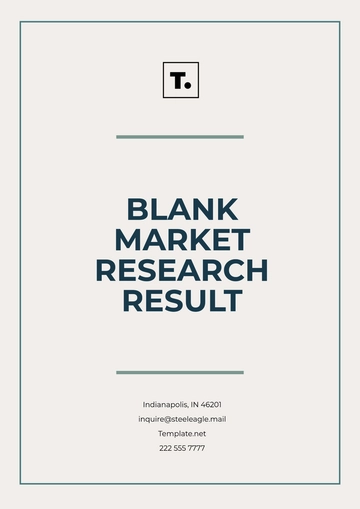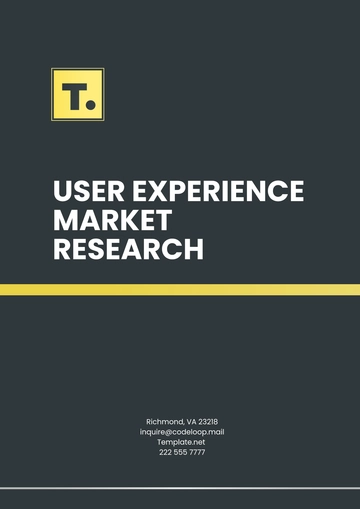Free Go-to-Market Research

I. Introduction
In the rapidly evolving business landscape of the year 2050, companies must develop data-driven, comprehensive strategies to launch their products and services effectively. For [Your Company Name], it is critical to understand the market dynamics, consumer behavior, competitive landscape, and technological trends to secure a successful product entry into the global market. This Go-to-Market (GTM) research provides an exhaustive analysis of the external market conditions and internal capabilities required for a product launch in 2050 and beyond.
The primary purpose of this report is to ensure that [Your Company Name] is well-equipped to navigate the complexities of the modern marketplace, identify profitable opportunities, and mitigate risks. As industries evolve and consumer preferences shift, a clear understanding of these variables becomes vital for successful market penetration. This report outlines the core components of the GTM strategy, including target market identification, competitive analysis, product positioning, pricing strategies, and distribution channels.
The focus of this research is to ensure that [Your Company Name] is well-positioned to penetrate new markets while maintaining scalability and sustainability in its operations. Additionally, this report highlights the strategic actions necessary to align [Your Company Name]’s resources with market demands, setting the stage for a successful product launch.
II. Market Landscape Analysis
A. Global Market Overview
The global market in 2050 is characterized by high levels of digitization, widespread adoption of artificial intelligence (AI), and the seamless integration of technologies like blockchain, quantum computing, and biotechnology into everyday life. This interconnectedness has reshaped consumer expectations and supply chain dynamics, creating both challenges and opportunities for companies.
Digital Economy Growth
By 2050, the global digital economy is projected to reach over $[200 trillion], driven primarily by e-commerce, AI-powered platforms, and digitally integrated industries. This massive digital shift provides [Your Company Name] with ample opportunity to launch products that align with the high demand for digital goods and services. Companies that can adapt quickly to this environment will thrive, making it essential for [Your Company Name] to leverage technology and innovation.Technological Trends
Emerging technologies such as quantum computing and AI have become cornerstones of innovation. Companies that can harness these technologies will have an advantage in terms of operational efficiency and the ability to offer cutting-edge products. For [Your Company Name], incorporating AI-driven customer insights into product development and marketing will ensure relevance in this tech-driven landscape.
B. Key Industry Segments
As we approach 2050, several industry segments present promising opportunities for market entry. These include health tech, renewable energy, AI-driven automation, and space exploration services.
Health Technology
By 2050, the global health tech market is expected to surpass $[5 trillion], driven by advancements in biotechnologies, personalized medicine, and AI diagnostics. The growing demand for health tech solutions presents a strong market opportunity for [Your Company Name], especially in regions with aging populations and increased health awareness. Innovations in telemedicine and wearable health monitors will be pivotal in shaping this segment.Renewable Energy
The renewable energy sector is experiencing exponential growth due to the ongoing global shift toward sustainability. By 2050, this market will likely be valued at $[10 trillion], with innovations in solar, wind, and nuclear fusion technologies leading the way. [Your Company Name] can explore products or services in this space, particularly in regions offering government incentives for clean energy solutions. In addition, the demand for energy storage solutions will continue to rise, presenting further opportunities.
Industry Segment | Market Size by 2050 | Key Growth Drivers |
|---|---|---|
Health Technology | $[5 trillion] | Aging population, AI diagnostics, telemedicine |
Renewable Energy | $[10 trillion] | Sustainability demand, technological advancements |
AI-driven Automation | $[8 trillion] | Efficiency gains, workforce transformation |
Space Exploration Services | $[1 trillion] | National investments, private sector innovation |
III. Target Market Identification
A. Demographic and Psychographic Segmentation
To successfully enter the market, [Your Company Name] must identify its target audience based on demographic and psychographic characteristics. Understanding the needs, behaviors, and preferences of these segments will guide effective product positioning and messaging.
Demographic Segments
By 2050, the global population is projected to reach [10 billion]. Notably, the fastest-growing demographic will be the "Silver Economy," or individuals aged [65+] due to global aging trends. This demographic is tech-savvy, health-conscious, and willing to spend on innovations that enhance their quality of life. They often seek solutions that promote convenience, ease of use, and better health management.Another key demographic is the Gen Z and Alpha populations, who are expected to make up [40%] of global consumers by 2050. These younger generations are digital natives, prioritizing environmental sustainability, social justice, and innovative technologies in their purchasing decisions. They are not only consumers but also advocates for brands that align with their values.
Psychographic Segments
Psychographic analysis reveals that consumers in 2050 prioritize personalization, convenience, and sustainability. The majority of consumers, particularly in urban areas, will demand products that align with their values of environmental responsibility and social impact. Additionally, a strong preference for subscription-based and AI-driven personalized solutions will be critical in product design. Brands that can engage consumers on emotional levels through storytelling and community-building efforts will gain a competitive edge.
B. Geographic Market Focus
Geographically, the Asia-Pacific region is expected to account for [60%] of global economic growth by 2050, making it a strategic market for [Your Company Name]. This region not only has a burgeoning middle class but also rapid urbanization and a high rate of digital adoption, presenting numerous opportunities for innovative product offerings.
Additionally, North America and Europe continue to be influential markets, particularly in high-tech sectors like AI and renewable energy. The key regions to consider are:
Asia-Pacific: With a growing middle class and high digital adoption rates, this region offers immense opportunities for digital products and services. Countries such as China, India, and Indonesia will be at the forefront of economic growth, fueled by investments in technology and infrastructure.
North America and Europe: Despite slower population growth, these regions will continue to dominate in technological innovation and consumer spending on premium, tech-driven products. The presence of venture capital and a focus on research and development in these regions will also support the growth of new technologies and startups.
Geographic Region | Key Opportunities | Projected Growth Rate |
|---|---|---|
Asia-Pacific | High digital adoption, growing middle class | [6%] per annum |
North America | Advanced technological infrastructure | [4%] per annum |
Europe | Sustainable products and innovation | [3%] per annum |
IV. Competitive Analysis
A. Direct Competitors
The competitive landscape in 2050 features established global players who have heavily invested in AI, blockchain, and biotechnology. For [Your Company Name], understanding their offerings and market strategies is essential for differentiating its product.
Competitor 1: AlphaTech Corp
AlphaTech Corp is a leader in AI-driven health tech solutions, with a projected market share of [25%] by 2050. Their success is driven by proprietary AI algorithms that offer unparalleled accuracy in diagnostics, making them a trusted brand in health technology. Their extensive R&D budget enables continuous innovation, keeping them ahead of competitors. To compete, [Your Company Name] needs to focus on product differentiation through user-friendly AI interfaces and superior customer service, positioning itself as a more accessible alternative.Competitor 2: GreenEnergy Solutions
GreenEnergy Solutions dominates the renewable energy sector, particularly in solar and wind technologies. Their innovative energy storage solutions allow them to maintain market leadership. They have successfully leveraged government partnerships to enhance their brand reputation and distribution networks. For [Your Company Name], offering a more cost-effective or scalable energy solution could provide a competitive advantage. Strategic partnerships with governments and NGOs could also enhance brand visibility and credibility.
Competitor Name | Market Share | Key Strengths | Weaknesses |
|---|---|---|---|
AlphaTech Corp | [25%] | Advanced AI algorithms, strong R&D | High price point |
GreenEnergy Solutions | [30%] | Comprehensive energy solutions, strong partnerships | Limited international presence |
B. Indirect Competitors
Indirect competitors include companies that do not directly compete with [Your Company Name]’s product but serve the same customer needs in alternative ways. For instance, traditional health service providers or fossil fuel companies might present indirect competition as consumers choose between conventional methods and newer technologies.
For example, a well-established hospital may provide diagnostic services that overlap with [Your Company Name]'s health tech solutions, potentially diverting attention from tech-based alternatives. Understanding these indirect competitors is vital for identifying potential collaborations or areas for market entry.
V. Product Positioning
A. Unique Value Proposition
[Your Company Name]’s product will be positioned as a premium, AI-driven solution designed to meet the demands of a tech-savvy, sustainability-conscious market. The core value proposition focuses on:
Innovation: Leveraging the latest in AI and quantum computing to deliver superior performance. This focus on cutting-edge technology will ensure that the product remains at the forefront of industry advancements.
Sustainability: Designed with minimal environmental impact, aligning with consumer values. Sustainability will not only be a selling point but a fundamental aspect of the product lifecycle, from production to disposal.
Personalization: Custom-tailored solutions based on AI-driven insights into consumer behavior. This personalization will be achieved through advanced data analytics that can predict user needs and preferences.
B. Differentiation Strategy
To differentiate from competitors, [Your Company Name] will emphasize its superior customer service, AI-powered personalized solutions, and eco-friendly product lifecycle. Marketing campaigns will highlight the product's ability to offer significant environmental benefits while maintaining cutting-edge technology.
Additionally, [Your Company Name] will engage with customers through educational content that informs them about the environmental impact of their choices, thus fostering a sense of community and shared values. This educational approach will not only build brand loyalty but also empower consumers to make informed decisions.
VI. Pricing Strategy
A. Pricing Models
The pricing strategy for [Your Company Name] will consider competitive pricing, market conditions, and consumer willingness to pay. The following models are proposed:
Subscription Model
As subscription-based services dominate the market in 2050, [Your Company Name] will offer its product through a tiered subscription system. This model ensures recurring revenue while allowing customers to upgrade or downgrade based on usage needs. Subscription prices will range from $[50] per month for basic features to $[200] per month for premium, AI-enhanced services. By creating multiple tiers, [Your Company Name] can cater to different consumer segments, maximizing market reach.Freemium Model
To attract a large user base, [Your Company Name] can adopt a freemium model, offering basic services for free while charging for advanced features. This strategy can drive early adoption, particularly among younger, budget-conscious consumers. By creating a seamless upgrade path from free to paid services, [Your Company Name] can increase customer lifetime value.
Pricing Model | Description | Target Segment |
|---|---|---|
Subscription Model | Tiered pricing from $[50] to $[200] | Broad market, varying needs |
Freemium Model | Basic services for free, premium features | Younger consumers, budget-conscious |
B. Price Sensitivity Analysis
Price sensitivity analysis shows that the average consumer in 2050 is willing to pay a premium for AI-driven, personalized, and sustainable products. However, regional variations exist, with consumers in North America and Europe exhibiting higher price elasticity compared to their counterparts in Asia-Pacific.
In addition to geographic factors, understanding the psychological pricing strategies that appeal to consumers—such as pricing at $[99] instead of $[100]—will further enhance sales effectiveness.
VII. Distribution and Sales Channels
A. Digital Platforms
By 2050, the majority of global sales transactions will occur via digital platforms. For [Your Company Name], developing a robust e-commerce infrastructure is crucial. The primary digital channels will include:
Own E-commerce Platform
[Your Company Name] will invest in its proprietary e-commerce platform, offering a seamless AI-driven shopping experience. Features like AI-powered chatbots, augmented reality product demos, and personalized recommendations will enhance the user experience. This platform will not only facilitate transactions but also collect valuable data on consumer behavior and preferences, allowing for continuous optimization of offerings.Third-party Platforms
Partnering with established e-commerce giants such as Amazon, Alibaba, and specialized B2B platforms will be crucial for market penetration. These partnerships provide access to a larger customer base while reducing the infrastructure costs associated with global logistics. By leveraging existing platforms, [Your Company Name] can accelerate its entry into new markets.
Distribution Channel | Description | Key Benefits |
|---|---|---|
Own E-commerce | Proprietary platform with personalized features | Full control, direct customer relationships |
Third-party platforms | Partnerships with major e-commerce sites | Wider reach, reduced overhead |
B. Physical Retail Partnerships
Despite the rise of e-commerce, physical retail will remain relevant, particularly for high-touch products where consumers prefer to experience the product firsthand. Partnerships with eco-friendly retailers and premium tech stores will help [Your Company Name] establish a presence in brick-and-mortar locations.
Moreover, pop-up shops in high-traffic urban areas can serve as a marketing tool, allowing consumers to interact with the product while generating buzz. Hosting events or demonstrations in partnership with retailers can further enhance brand visibility and customer engagement.
VIII. Marketing and Promotion Strategy
A. Digital Marketing
The marketing strategy for 2050 focuses heavily on AI-driven, personalized advertising across social media, search engines, and digital assistants.
AI-Powered Personalization
By leveraging AI, [Your Company Name] will target specific consumer segments with personalized marketing messages, increasing relevance and engagement. Predictive analytics will allow for real-time adjustments to campaigns based on consumer interactions. This approach not only improves the return on investment (ROI) for marketing campaigns but also fosters a deeper connection with customers.Social Media and Influencers
Social media continues to dominate marketing in 2050, with AI-curated content and influencers playing a significant role in shaping consumer opinions. Collaborating with key influencers, particularly those aligned with environmental sustainability, will amplify [Your Company Name]'s brand message. Creating compelling content that encourages sharing will further enhance brand reach and awareness.
B. Public Relations and Thought Leadership
Positioning [Your Company Name] as an industry leader in AI and sustainability will be essential for building brand credibility. This will involve publishing thought leadership content, hosting webinars, and speaking at industry conferences on topics related to technology, sustainability, and innovation.
By engaging with media outlets and industry publications, [Your Company Name] can enhance its visibility and establish itself as a go-to source for information on emerging trends. Strategic partnerships with universities and research institutions can also elevate the brand’s reputation and foster innovation.
IX. Financial Projections
A. Revenue Forecast
Based on the market potential and product demand, [Your Company Name] is projected to generate revenues of $[500 million] in its first year of product launch, with a compound annual growth rate (CAGR) of [20%] over the next five years. Key revenue drivers will include subscription fees, premium service packages, and partnerships with third-party platforms.
This forecast takes into account market trends, competitive pricing strategies, and consumer behavior analytics. Revenue streams will also diversify as [Your Company Name] expands its product offerings and enters new markets.
B. Profitability
With an initial investment of $[100 million] in R&D, marketing, and infrastructure, [Your Company Name] expects to achieve profitability by year [3] of product launch, with gross margins reaching [60%] by year [5]. Strategic cost management and efficient use of AI in operational processes will drive profitability.
Investing in automation and AI will reduce operational costs and enhance productivity, enabling [Your Company Name] to scale operations effectively. Regular financial reviews and strategic adjustments will ensure alignment with market changes and maintain profitability.
Financial Metric | Year 1 | Year 3 | Year 5 |
|---|---|---|---|
Projected Revenue | $[500 million] | $[900 million] | $[1.5 billion] |
Gross Margin | [40%] | [50%] | [60%] |
Initial Investment | $[100 million] |
X. Conclusion
By 2050, the business landscape will be driven by technological advancements, particularly AI, sustainability, and personalized consumer experiences. [Your Company Name] is well-positioned to enter this market with a robust Go-to-Market strategy. This research has identified key market opportunities, competitors, and pricing models that align with future consumer demands, ensuring that [Your Company Name] can achieve sustained growth and market leadership in the years ahead.
The comprehensive analysis provided in this report emphasizes the importance of adaptability and innovation in a rapidly changing marketplace. By understanding market dynamics and consumer behavior, [Your Company Name] can strategically position itself for success. The steps outlined in this GTM research serve as a roadmap to effectively navigate the complexities of the 2050 market, enabling [Your Company Name] to realize its vision and objectives while delivering value to its customers and stakeholders.
- 100% Customizable, free editor
- Access 1 Million+ Templates, photo’s & graphics
- Download or share as a template
- Click and replace photos, graphics, text, backgrounds
- Resize, crop, AI write & more
- Access advanced editor
Gather essential insights with the Go-to-Market Research Template from Template.net. This editable and customizable template guides you through collecting and analyzing market data, competitor landscape, and customer preferences. Utilize our Ai Editor Tool to customize it for thorough research that informs your market strategy.





























